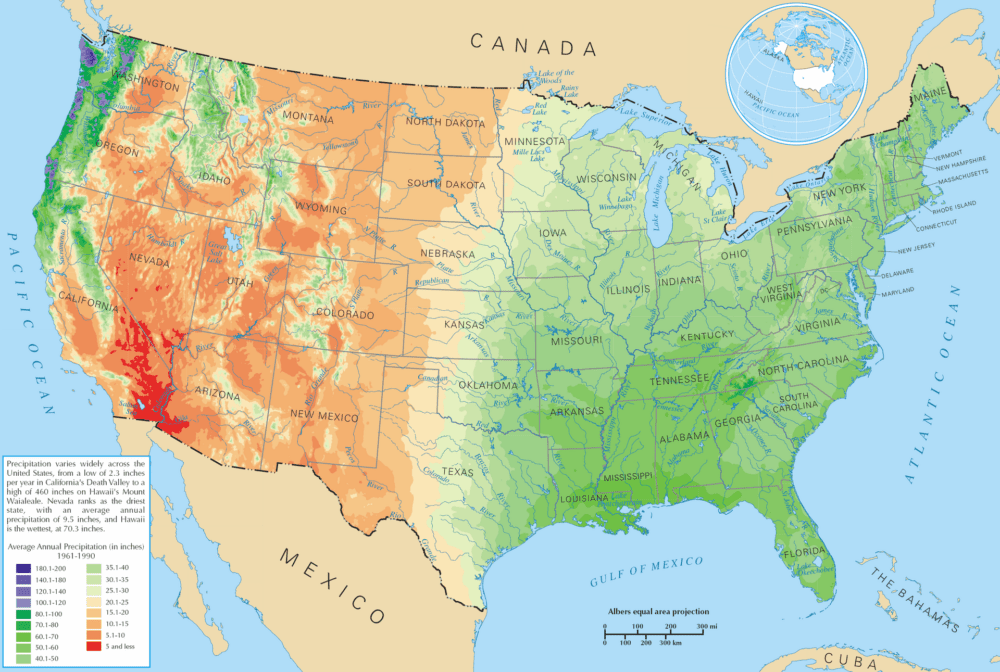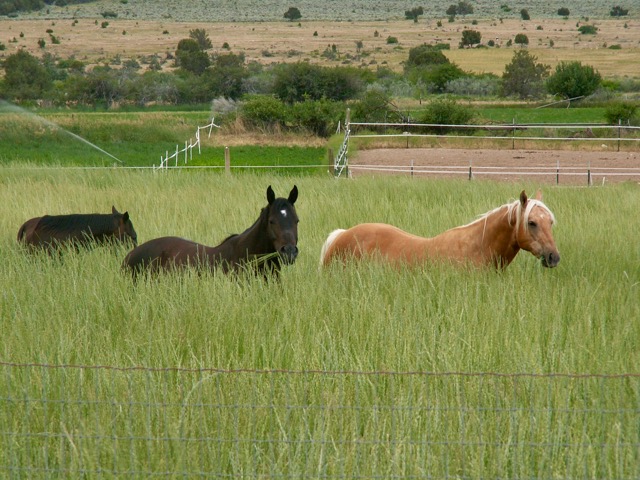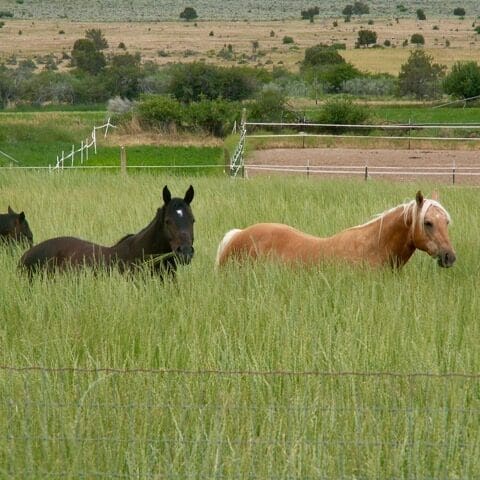Dryland Pasture Mix is one of our best selling products. It has been planted with great success in every state west of the Mississippi River, Canada and Mexico and many eastern states. This post should address questions and help you decide if it is best for your application. If you would like to order Dryland Pasture Mix, follow this link.
Dryland Pasture: Defining Dryland
Water is the single most precious resource in the the Western United States. The Intermountain West is a dichotomy of hot, dry summers and cold, snowy winters. Daily fluctuations are as dramatic as the seasons; in a given day there may be morning frost or ice and daytime highs can be in the 80’s. The Intermountain West covers Montana, Idaho, Nevada, Utah, Wyoming, Colorado, and eastern Washington and Oregon. Our dryland pasture mix is especially suited to these states and the challenging conditions they present but is suitable in other states as well.
They definition of “dryland” is relative and may vary depending upon where you live. It’s a matter of perspective and point of reference. I once had a customer from the pacific northwest call and tell me they needed a dryland species because they were in a terrible drought. When I asked how they defined drought the reply was “we’ve only received eighty-five inches, and the wet season is almost over!” They were genuinely concerned, and in an area that usually average of 175″ of annual precipitation they were, in fact, in a very serious drought. Compared, however, to the arid high deserts of the Great Basin, 85″ is nearly triple the amount of annual precipitation received in the worst flood years in recorded history. That much water would drown every living thing in sight and wash us into the Great Basin hardpan.
The map below indicates by color the major precipitation zones in the United States. It is graduated by precipitation in inches. You can tell at a glance where your location falls. Several good online resources provide additional precipitation, temperature and snowfall data based on your zip code. I recommend you have a look at those sites and become familiar with the precipitation characteristics of your area. A couple of sites include:
- U.S. Climate Data (our favorite – it’s east to use, easy to read)
- NOAA (National Weather Service Forecast)
Once you have established the zone you live in, you can determine which species will grow in your area, and if they will survive solely on natural annual precipitation or if they need supplemental irrigation.

Choosing a seed mix based on precipitation:
The species in our dryland pasture seed mix is designed for geographic areas where natural annual precipitation is a minimum of 10-14″ with no supplemental irrigation. If you have more than 14″ then other species are adapted to your climate and you may want to consider an irrigated pasture mix or a custom mix. Rainfall in the Great Basin and Intermountain West rarely average more than 14 inches, an in most areas is closer to 10-12″ Yes, there are areas that receive as much as 18″, but they are generally high mountain valleys or actual mountain ranges, and length of growing season and temperatures play a larger role in choosing species than precipitation.
Species for your precipitation zone:
Anything less than 14 inches of annual precip is how we define dryland. Our dryland pasture mix will grow on as little as 10″. We offer species that will grow in less than 10″ but choosing seed for that level of aridity usually requires a custom mix, so we work with you directly in those circumstances. It’s difficult to build a “one mix fits all” for extreme geographic regions, which include the mojave and sonoran deserts.
The table below is a quick-refence for choosing species based solely on their precipitation requirements.
Dryland Species by Annual Precipitation
| Species | Min Precip | Range of Adaptability | Plant Form |
|---|---|---|---|
| Snake River Wheatgrass | 8 | 8-20 inches | Grass |
| Intermediate Wheatgrass | 11 | 11-36 inches | Grass |
| Hycrest Crested Wheatgrass | 7 | 7-15 inches | Grass |
| Bluebunch Wheatgrass | 8 | 8-20 inches | Grass |
| Siberian Wheatgrass | 5 | 5-36 inches | Grass |
| Indian Ricegrass | 7 | 7-15 inches | Grass |
| Thickspike Wheatgrass | 6 | 6-20 inches | Grass |
| Western Wheatgrass | 8 | 8-20 inches | Grass |
| Russian Wildrye | 7 | 7-16 inches | Grass |
| Basin Wildrye | 8 | 8-24 inches | Grass |
| Sheep Fescue | 9 | 9-24 inches | Grass |
| Sand Dropseed | 6 | 6-11 inches | Grass |
| Smooth Brome | 12 | 12-20 inches | Grass |
| Idaho Fescue | 12 | 12-20 inches | Grass |
| Bottlebrush Squirreltail | 7 | 7-20 inches | Grass |
| Slender Wheatgrass | 10 | 10-18 inches | Grass |
| Tall Fescue | 16 | 16-40+ inches | Grass |
| Needle and Thread Grass | 6 | 6-18 inches | Grass |
| Sandberg Bluegrass | 7 | 7-20 inches | Grass |
| Hard Fescue | 12 | 12-30 inches | Grass |
| Prairie Junegrass | 10 | 10-24 inches | Grass |
| Paiute Orchardgrass | 11 | 11-22 inches | Grass |
| Perennial Ryegrass | 14 | 14-36 inches | Grass |
| Tall Wheatgrass | 8 | 8-28 inches | Grass |
| AC Saltlander | 10 | 10-18 inches | Grass |
| Pubescent Wheatgrass | 11 | 11-20 inches | Grass |
| Dahurian Wildrye | 11 | 11-24 inches | Grass |
| Sainfoin | 14 | 14-24 inches | Broadleaf |
| Small Burnet | 12 | 12-28 inches | Broadleaf |
| Yellow Blossom Sweetclover | 8 | 8-32 inches | Broadleaf |
| Blue Grama | 8 | 8-14 inches | Grass |
| Ranger Alfalfa | 11 | 11-36 inches | Broadleaf |
| Ladak Alfalfa | 11 | 11-36 inches | Broadleaf |
| Immigrant Forage Kochia | 6 | 6-16 inches | Broadleaf |
As you look through the list above, you will notice that there are several species that are well adapted to arid landscapes but are not found in dryland pasture mix. Why? One reason is cost. Species like Snake River and Bluebunch Wheatgrass work very well in dryland conditions but can be cost prohibitive. We can certainly add them to a custom mix, but they price a pasture mix outside the range of what the average person really requires or can afford. Another reason is forage production. Indian Ricegrass, for example, is one of the most drought tolerant species available but produces very little forage, and the forage it does produce is not ideal.
Stacking the odds in your favor:
Some planting sites fall into the realm of not quite dryland but not quite irrigated, either. I recommend erring on the side of caution. Go with the species that will tolerate droughty conditions and survive on less water. Why? Because part of the selection process also hinges upon WHEN the water comes. If you plant a fescue that requires a minimum of 14″ of annual precipitation, but your water comes in the form of rain in spring or fall, then your fescue will eventually thin out and die in the hot, dry mid summer months. On the other hand, drought tolerant species will better weather hot summer months, persist, and produce more forage if they are given supplemental water or are planted in areas with slightly higher annual precip. Intermediate Wheatgrass, for example, can be very drought tolerant and will grow on as little as 11″ annual precipitation and it is almost always a component of our dryland pasture mix. But it really shines as a pasture and hay grass between 14″ and 20″. Plants, like all living things, have a minimum threshold for survival. Maximum performance lies somewhere between extremes. Err on the side of drought tolerance.

Forage Production:
Dryland Pasture Mix provides excellent forage. In areas of 12+ inches of annual precipitation it has been and bailed at least once annually. It can be fall and winter grazed as pasture. Once established it can be grazed in any season, but reasonable rotation is required for plants to recover. Sufficient green matter should remain through summer months to encourage re-growth, photosynthesis, etc. The ability to cut dryland pasture mix as hay will depend upon your water, soil profile, grazing habits and any number of environmental conditions. Where sufficient resources are available, a drought tolerant pasture mix is an excellent dual-purpose product adapted to a wide range of dryland ecosystems. It is efficient and multi-purpose.
Dryland pasture mix for weed control:
Dryland Pasture Mix is effective for disturbed sites, restoration and weed control. It competes well with weeds if you can beat the life cycle of invasive annuals and give your seed a head start. Prepare your seedbed and treat weeds prior to planting. Refer to my post an seedbed preparation and sowing.
One of the great benefits of a grass pasture mix is the ability to spray for invasive broadleaf species. We do not generally add broadleaves to our pasture mix so it can be spray once the stand is established. Of course, we can add broadleaves to the mix – just know that you will kill them if you spray.
[rev_slider alias=”drylandpasture”]
Sowing:
Best results are achieved by drill seeding, but broadcast seeding is the most common method and is very successful. Plant no deeper than .25″. Prepare the soil with some form of light disturbance such as a spike-tooth harrow. Methods will vary from sit to site and will depend upon your equipment. For those with small tracts of land or limited equipment, a hard-tooth rake will suffice, or an old piece of fencing drug behind a truck or ATV. Some disturbance is better than no disturbance.
Dryland pasture mix can be sown any time of year if your seeding is kept wet, especially during germination and establishment stages. If you are supplementing annual precipitation and your water is scarce the best planting time is late fall (September-October). Seed will lay dormant until spring in late fall planting scenarios. Spring is also a great time assuming you can work the ground. Plant no deeper than 1/4″
Seeding Rate for Dryland Pasture Seed Mix:
16 lbs./acre drilled (1/4″ maximum depth)
20 lbs./acre broadcast.
*Refer to the analysis tags for actual percentages and mixture ingredients, planting instructions and additional helpful information.
